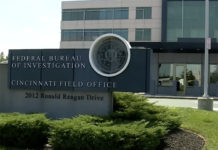
By Associated Press and Shivali Best for Mail Online
An incredible new fingerprint algorithm is helping the FBI to identify bodies dating back to the 1970s.

The algorithm can make matches from low-quality prints or even a single finger or thumb.
Previously, the standard algorithm typically needed quality prints from all 10 fingers to make a match.
Since launching the new effort in February, the FBI has identified 204 bodies found between 1975 and the late 1990s.
Over the past year, the FBI and local medical examiner offices have identified bodies from across the US, with the largest number in Arizona, California, New York, Florida and Texas.
‘We didn’t know the actual potential success. We were hoping to identify a few cases, maybe five or 10,’ said Bryan Johnson, a manager in the FBI’s Latent Fingerprint Support Unit who proposed the effort.
‘We’re really proud that we found another way of doing this.’
(Using a new computer algorithm, an FBI unit has taken another look at fingerprints from about 1,500 bodies found years or even decades ago and succeeded in making more than 200 matches to prints previously on record. Courtesy of The Associated Press and YouTube)
Under the new program, Mr Johnson and eight others in the FBI unit ran fingerprints from about 1,500 bodies through a new computer algorithm that could make matches from low-quality prints or even a single finger or thumb.
Previously, the standard algorithm typically needed quality prints from all 10 fingers to make a match.
Over the past year, the FBI and local medical examiner offices have identified bodies across the US, with the largest number in Arizona, California, New York, Florida and Texas.

We didn’t know the actual potential success.
We were hoping to identify a few cases, maybe five or 10,’ said Bryan Johnson, a manager in the FBI’s Latent Fingerprint Support Unit who proposed the effort.
‘We’re really proud that we found another way of doing this.’
Under the new program, Mr Johnson and eight others in the FBI unit ran fingerprints from about 1,500 bodies through a new computer algorithm that could make matches from low-quality prints or even a single finger or thumb.
Previously, the standard algorithm typically needed quality prints from all 10 fingers to make a match.
The unit is now urging local authorities to search through other old case files and send in smudged or partial prints that couldn’t previously be matched.
(Learn More. Intelligent Fingerprinting has developed a revolutionary new fingerprint drug test, the first of its kind in the world. The portable, non-invasive, fingerprint-based Drug Screening System works by analyzing fingerprint sweat to detect tiny traces of drugs or drug metabolites. It takes only a few seconds to collect a fingerprint sample onto the Intelligent Fingerprinting Cartridge, ready for analysis by the portable Intelligent Fingerprinting Reader 1000. The Intelligent Fingerprinting 4-panel fingerprint drug test screens for opiates, cocaine, cannabis and amphetamines. Results are available in under 10 minutes. Courtesy of Intelligent Fingerprinting and YouTube)
Identifying the Body of John Downey

One of the key cases that the new algorithm has helped to solve is that of John Downey, who disappeared after Thanksgiving in 1983.
This spring, Mr Downey’s brother, James, received a call from authorities, reporting that the remains of a man found beaten to death decades ago along a brushy path in Des Moines, 800 miles away, had been identified as John.
‘We always figured something had happened to him,’ James Downey said from his home in Houston.

‘We all assumed he’d got killed somewhere or died in an accident.’
The FBI’s newfound ability was key to the Des Moines case because by the time Mr Downey’s body was found in February 1984, it has been buried under snow and dirt for months and was severely decomposed.
Authorities sought the public’s help in identifying the body, including publishing drawings of distinctive tattoos in the local newspaper, but no one came forward.

‘We know he was murdered and dumped in this area but Des Moines police never really developed any leads on it and basically forgot about the case,’ county Medical Examiner Greg Schmunk said.
It was one of several cases that medical examiner investigators called ‘shelf dwellers,’ referring to cremated remains that would sit for decades on storage shelves.
But the fact that this was a homicide and the unusual tattoos –

- including a skeleton clad in Nazi garb and a cartoon figure wearing a hat and smoking a cigarette –
- prompted investigators to rummage through police archives and resubmit the single available thumbprint into the Missing and Unidentified Persons System, called NamUs.
They were shocked months later when the FBI’s Johnson called to confirm they had matched the thumbprint to prints of Downey taken after an earlier arrest in Texas.
About 40 per cent of the identifications through the FBI’s new process have been cases in Arizona.
Most are people who died while trying to make the dangerous desert crossing from Mexico.

Bruce Anderson, the forensic anthropologist for Pima County, Arizona, keeps more than 1,000 unidentified person charts filed along his office wall.
‘If you can remove one of these charts, have one family reach out to you to confirm an identity, some of that weight on us is removed,’ Mr Anderson said.
Aden Naka, assistant director for forensics investigation in New York City, said many of the new identifications there were of bodies found in water, with some dating back to the early 1990s.

Once they had a match, Mr Naka said, staffers tried to find relatives or aid a criminal investigation if one is open.
‘This matters tremendously,’ Mr Naka said. ‘Everyone deserves a name.’
How Does it Work?
The computer algorithm can make matches from low-quality prints or even a single finger or thumb by looking at a variety of patterns in the prints.
It can be used to identify bodies dating back to the 1970s.
Previously, the standard algorithm typically needed quality prints from all 10 fingers to make a match.

Since launching the new effort in February, the FBI and local medical examiner offices have identified 204 bodies found between 1975 and the late 1990s.
The cases stretch across the country, with the largest number in Arizona, California, New York, Florida and Texas.
Original post http://www.dailymail.co.uk/sciencetech/article-5034215/New-fingerprint-algorithm-helps-ID-bodies-decades-ago.html






















